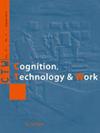An innovative sit-standing seat in urban buses: A new design to prevent falls and non-collision injuries.
IF 3.4
3区 工程技术
Q2 ENGINEERING, INDUSTRIAL
引用次数: 0
Abstract
BACKGROUND Due to the rapid growth of metropolises and the insufficiency of public transportation, nowadays, many people travel on these vehicles in a standing position. This position leads to discomfort and the risk of falling or non-collision incidents for the passengers. OBJECTIVE The present study was conducted to analyze an innovative sit-standing seat to prevent falls and non-collision injuries in standing passengers. METHODS A total of sixteen participated in this study. EMG signal and Borg scale were used to assess muscle activity and discomfort, respectively. RESULTS The mean Borg scale score for perceived discomfort was lower in the sit-standing position than the standing position in all body organs, except for the hips. Also, in the sit-standing position, the muscle activity of the soleus and medial gastrocnemius muscles was significantly lower in the constant velocity and entire phases in both legs, lower in the right leg in the acceleration phase and lower in the left leg in the deceleration phase. CONCLUSIONS So this seat can be used as an innovative idea to improve the ergonomic condition of standing passengers to prevent falls and non-collision injuries on transit buses.一种创新的城市公交车坐立两用座椅:一种防止跌倒和非碰撞伤害的新设计。
由于大都市的快速发展和公共交通的不足,现在很多人都是站着出行的。这种姿势会导致乘客不舒服,并有摔倒或发生碰撞事故的风险。目的研究一种新型的坐立两用座椅,以防止站立乘客跌倒和非碰撞伤害。方法共16例患者参加本研究。肌电图信号和博格量表分别用于评估肌肉活动和不适。结果除髋部外,坐立体位的博格评分均低于站立体位。同时,在坐立体位下,比目鱼肌和腓肠肌内侧肌的肌肉活动在两腿匀速和全速阶段均明显降低,在加速阶段右腿较低,在减速阶段左腿较低。结论该座椅可以作为一种创新思路,改善公交乘客站立时的人体工程学状况,防止乘客跌倒和碰撞伤害。
本文章由计算机程序翻译,如有差异,请以英文原文为准。
求助全文
约1分钟内获得全文
求助全文
来源期刊

Cognition Technology & Work
ENGINEERING, INDUSTRIAL-
CiteScore
6.90
自引率
7.70%
发文量
26
审稿时长
>12 weeks
期刊介绍:
Cognition, Technology & Work focuses on the practical issues of human interaction with technology within the context of work and, in particular, how human cognition affects, and is affected by, work and working conditions.
The aim is to publish research that normally resides on the borderline between people, technology, and organisations. Including how people use information technology, how experience and expertise develop through work, and how incidents and accidents are due to the interaction between individual, technical and organisational factors.
The target is thus the study of people at work from a cognitive systems engineering and socio-technical systems perspective.
The most relevant working contexts of interest to CTW are those where the impact of modern technologies on people at work is particularly important for the users involved as well as for the effects on the environment and plants. Modern society has come to depend on the safe and efficient functioning of a multitude of technological systems as diverse as industrial production, transportation, communication, supply of energy, information and materials, health and finance.
 求助内容:
求助内容: 应助结果提醒方式:
应助结果提醒方式:


